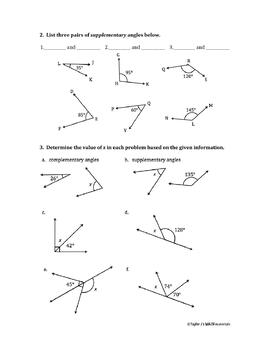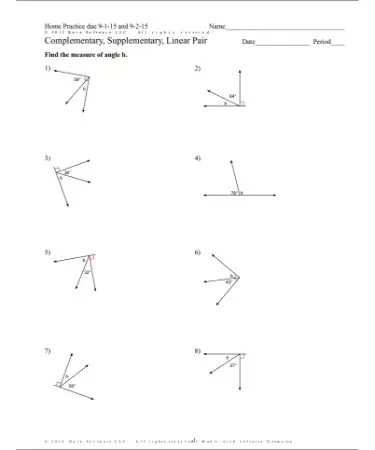

- #Complementary and supplementary angle worksheet how to#
- #Complementary and supplementary angle worksheet series#
This is where understanding angle relationships is key, it will allow you to understand some many other measures with little to no effort.
#Complementary and supplementary angle worksheet how to#
Imagine building a deck and calculating how to make a perfect curve or bend around a house or obstacle. Whether you realize it or not people that work on construction jobs use these concepts every single day. While this a great skill to have to do well on test, it also has huge real-world implications for you. You can use this skill to tell you the measures of angles you do not know without ever measuring a thing. The Importance of Describing Angle Relationshipsīeing able to recognize connections between different angles has a great deal value for you as you approach geometry and other practical applications of math. Once again this is an essential for your more advanced proofs. When the sum of two angles is 180 degrees, we say that they are a supplement to each other. The two angles forming a supplementary angle make a straight angle. Supplementary Angle - Supplementary angles are formed when two angles add up to 180 degrees. If you see a right angle available, when writing proofs, you can pretty much bet the farm this this term will be included.

As you advance on with geometry this will become a foundational term that will help you when crafting geometric proofs. Since these angles add up to 90 degrees, the two angles forming a complementary angle area always acute. Complementary angles always have a positive measure. While talking about one of the angles in complementary pair, we say that one angle is complementary of the other or is the complement of the other. When studying the complementary angles, it is crucial to remember that they come in pairs. Below, we have discussed the most common type of relationship between two angles.Ĭomplementary Angle - Complementary angles are formed by two angles that add up to 90 degrees. Several types of relationships that can be formed by using the angles. In geometry, an angle is described as a figure formed by two rays meeting at the vertex.

What Are Complementary and Supplementary Angles?Īn angle is a way of defining the relationship between two lines that start at the same point. If there is no complement or supplement is possible state "None".

#Complementary and supplementary angle worksheet series#
The homework is a building series and really enhances their skills.


 0 kommentar(er)
0 kommentar(er)
